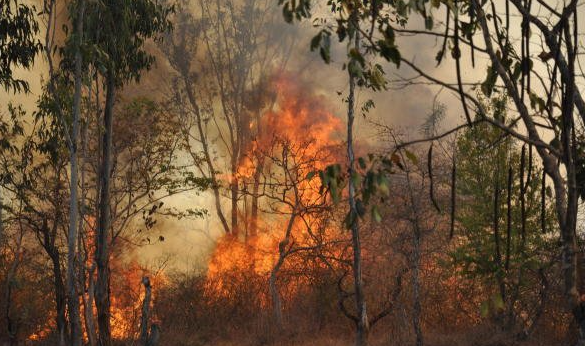A forest fire which started in Simlipal in February and has been raging for nearly a week now, was finally brought under control. How fire prone is the forest? What caused the fire, and how intense was it?
The Simlipal forest reserve area frequently witnesses forest fires during dry weather conditions. A fire which started in the biosphere reserve area in February and has been raging for nearly a week now, was finally brought under control.
What is the Simlipal Biosphere reserve?
Simlipal, which derives its name from ‘Simul’ (silk cotton) tree, is a national park and a tiger reserve situated in the northern part of Odisha’s Mayurbhanj district. Simlipal and the adjoining areas, comprising 5,569 sq. km, was declared a biosphere reserve by the Government of India on June 22, 1994, and lies in the eastern end of the eastern ghat.
Simlipal is the abode of 94 species of orchids and about 3,000 species of plants. The identified species of fauna include 12 species of amphibians, 29 species of reptiles, 264 species of birds and 42 species of mammals, all of which collectively highlight the biodiversity richness of Simlipal. Sal is a dominant tree species.
How intense was the fire?
According to the Regional Conservator of Forests Simlipal, Maloth Mohan, a total of 399 fire points have been identified in the fringe areas bordering the forest, close to the villages. “All of them have been attended to, and the fire is now brought under control,” he said.
How fire prone is Simlipal forest?
Generally, with the onset of summers and towards the end of autumn, the forest area remains vulnerable to forest fires. They are a recurrent annual phenomenon, but are also brought under control due to short span of precipitation. The months of January and February witness rainfall of 10.8 and 21 mm, respectively. The last incident of a major forest fire was reported in 2015.
This duration coincides with the shedding of deciduous forests in the forest areas. The fallen leaves are more vulnerable to catching fire and facilitate the spreading of these forest fires quickly over the entire forest area.
What causes the fire in Simlipal?
Natural causes such as lighting or even soaring temperatures can sometimes result in these fires, but forest officials and activists say most of the fires can be attributed to man-made factors.
With dried leaves and tree trunks, even a spark can lead to a raging fire. According to wildlife activist Bhanumitra Acharya, who has worked closely with the forest reserve for the last 28 years, instances of poaching and hunting wherein the poachers set a small patch of forest on fire to divert the wild animals can lead to such fires. “They do not douse the fire after hunting… this particular time is very vulnerable for fires to spread quickly,” Acharya said.
To buy our online courses Click Here
Secondly, jungle areas are also set on fire by villagers to clear the dry leaves on the ground for easy collection of mahua flowers. These flowers are used to prepare a drink which is addictive in nature. Villagers also believe burning patches of Sal trees will lead to better growth when planted again. The transition zone of the reserve has 1,200 villages with a total population of about 4.5 lakh. Tribal constitute about 73 per cent of the population. This year, along with man-made factors, an advanced heat wave with the early onset of summer further deteriorated the condition.
How are these forest fires controlled and prevented?
Such fires are generally brought under control by natural rains. Forecasting fire-prone days and including community members to mitigate incidents of fire, creating fire lines, clearing sites of dried biomass, and crackdown on poachers are some of the methods to prevent fires. The forest fire lines which are strips kept clear of vegetation, help break the forest into compartments to prevent fires from spreading.
This year, the forest department intensified its mitigation measures and formed a squad each for 21 ranges across the five divisions to closely monitor the situation. 1,000 personnel, 250 forest guards were pressed into action. 40 fire tenders and 240 blower machines were used to contain the blaze. Awareness programme are also being initiated at a community level to prevent such incidents.




